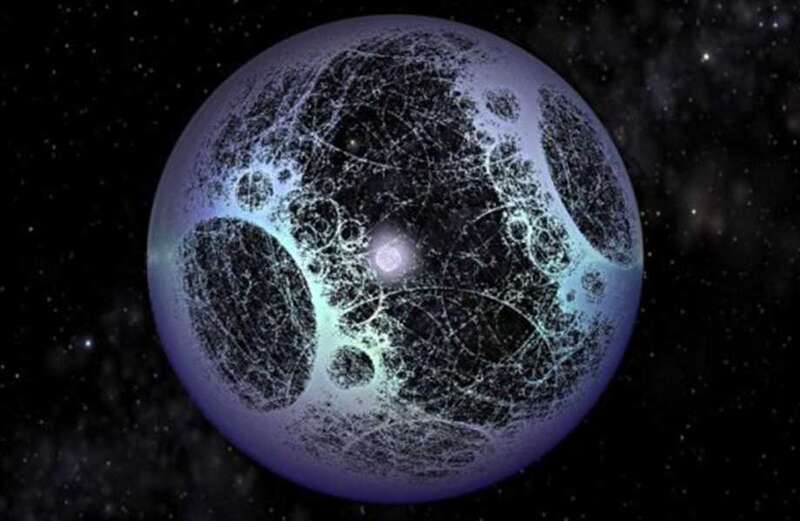FOUR mysterious stars might be alien mega-structures built to harvest energy output, researchers have hinted.
The hypothetical structures dubbed Dyson spheres are being examined for evidence of alien technological civilizations.



A team of astronomers has been examining recent astronomical survey data, said Simon Goodwin, Professor of Theoretical Astrophysics, University of Sheffield, in the UK.
They are looking for possible large-scale engineering projects in space.
The experts have been attempting to identify seven candidates for hypothetical alien megastructures, known as Dyson spheres, “deserving of further analysis”.
 Charming UK village is 'UFO hotspot' with 'NASA scientists showing interest'
Charming UK village is 'UFO hotspot' with 'NASA scientists showing interest'
They’d take up more and more space until they eventually surrounded almost the entire star like a sphere.
Simon Goodwin, Professor of Theoretical Astrophysics
Dyson spheres are massive structures built around stars to collect their energy.
They were first proposed by the physicist Freeman Dyson 64 years ago as a possible way for an advanced civilization to harness a star’s power.
"Consisting of floating power collectors, factories and habitats, they’d take up more and more space until they eventually surrounded almost the entire star like a sphere," wrote Goodwin in The Conversation.
"Dyson reasoned that a signature would be detectable, such as an excess of infrared radiation," explained Science Alert.
SEVEN MYSTERY OBJECTS
The seven objects are all located within 1,000 light-years of Earth.
They are termed “M-dwarfs” which is a class of stars that are smaller and less bright than our own Sun.
For more than 60 years, astronomers have searched the skies for artificial signals and other signs of extraterrestrial civilizations," said researchers involved in Project Hephaistos, a scientific search for intelligent life in outer space.
"Yet no evidence of intelligent life beyond the Earth has so far emerged."
The researchers have been delving in to data on the seven M type stars from a sample of five million stars.
 Astronomer leads hunt for Northern Lights 'sound' rarely heard in the aurora
Astronomer leads hunt for Northern Lights 'sound' rarely heard in the aurora
"The classical way to search for Dyson spheres is to look for their waste heat signatures at infrared wavelengths," said the Uppsala University-based team in Sweden.
"A near-complete Dyson sphere will significantly dim the optical light of the star it surrounds.
In regards to three of the stars, they concluded they were unlikely to be Dyson spheres.
Instead, it is believed they are part of a distant galaxy obscured by dust.
INFRARED ENERGY
The presence of dust would contaminate the infrared energy distribution, explained Science Alert.
"What of the other four candidates? To date, no matching radio source has been found," the website added.
"Light can be a signature of a lot of other things, such as a disc of gas and dust, or discs of comets and other debris," said Goodwin in regards to the new research.
"But the seven promising candidates aren’t obliviously due to a disc, as they weren’t good fits to disc models.
"It is worth noting there is another signature of a Dyson sphere: that visible light from the star dips as the megastructure passes in front of it.
"Such a signature has been found before.
"There was a lot of excitement about Tabby’s star, or Kic 8462852, which showed many really unusual dips in its light that could be due to an alien megastructure."
SPACE DUST
The Astrophysical Journal Letters said in 2018 that the dimming of Tammy's star could be due to some sort of dust, although the cause remains uncertain.
"For more than 60 years, astronomers have searched the skies for artificial signals and other signs of extraterrestrial civilizations, yet no evidence of intelligent life beyond the Earth has so far emerged," said Project Hephaistos.
"We already know that planets are common - more than 2000 planets around other stars have already been detected (including several planets with properties reasonably similar to Earth).
"If one adopts the position that intelligent life should not be unique to our planet, this then leads to an apparent contradiction.
"If there is intelligent life beyond elsewhere in the Universe, why don’t we see any signs of this?"
TECHNOSIGNATURES
Nasa published a piece last year about scientists beginning to consider what technological traces of intelligent life – or “technosignatures” – might look like.
"They wouldn’t come from planets in our solar system, but rather far-flung exoplanets that we cannot see up close," the article said.
"Among the possibilities are laser or radio pulses, signs of artificial chemicals in the atmospheres of distant planets, or Dyson spheres – massive structures built around stars to collect their energy."
ALIEN LIFE
Astronomer Jill Tarter told Nasa the search for signs of alien tech was reaching beyond just radio signals from space.
“Nasa is fully committed to the search for life being one of its key science goals," said Nick Siegler, chief technologist for the Exoplanet Exploration Program at NASA’s Jet Propulsion Laboratory in Southern California.
“Technosignatures will be part of the continuum of evidence of life we will search for on exoplanets.”



































